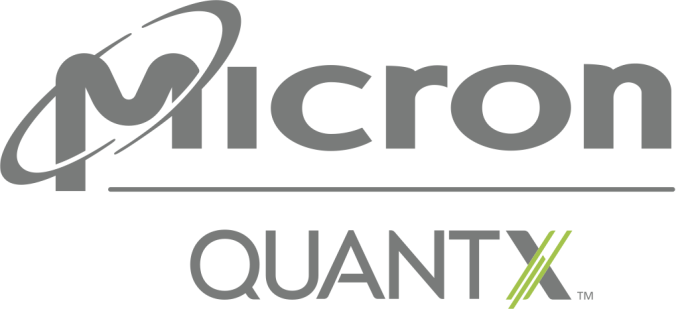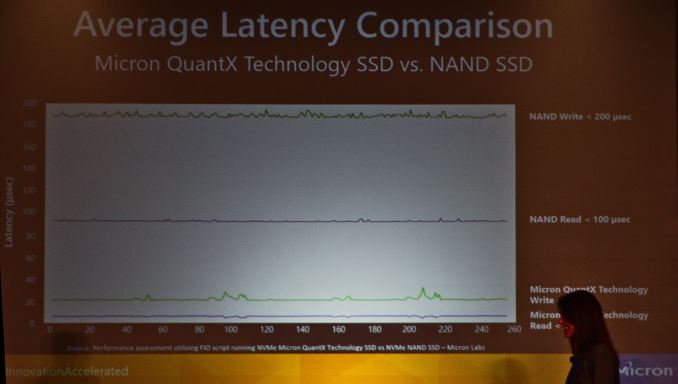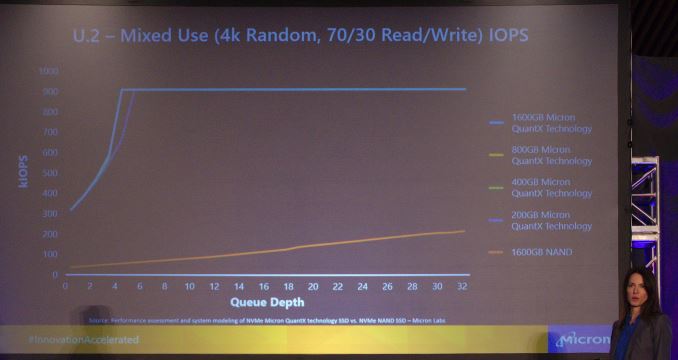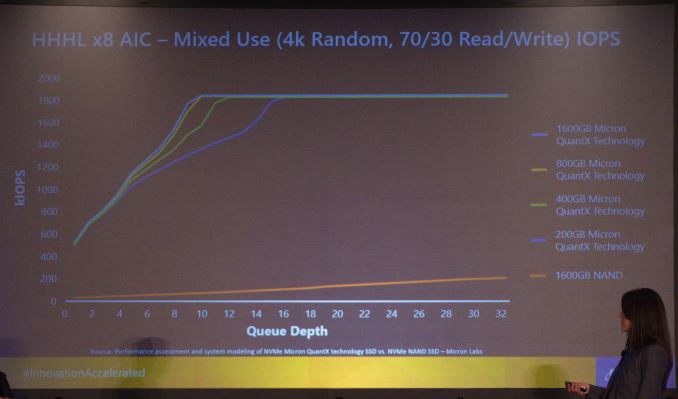Micron Announces QuantX Branding For 3D XPoint Memory (UPDATED)
by Billy Tallis on August 9, 2016 10:45 AM EST- Posted in
- SSDs
- Micron
- 3D XPoint
- Flash Memory Summit
- QuantX

In a keynote speech later this morning at Flash Memory Summit, Micron will be unveiling the branding and logo that their products based on 3D XPoint memory will be using. The new QuantX brand is Micron's counterpart to Intel's Optane brand and will be used for the NVMe storage products that we will hear more about later this year. 3D Xpoint memory was jointly announced by Intel and Micron shortly before last year's Flash Memory Summit and we analyzed the details that were available at the time. Since then there has been very little new official information but much speculation. We do know that the initial products will be NVMe SSDs rather than NVDIMMs or other memory bus attached devices.
In the meantime, Micron VP Darren Thomas goes on stage at 11:30 AM PT, and we'll update with any further information.
UPDATE:
Micron's keynote reiterated their strategy of positioning 3D XPoint and thus QuantX products in between NAND flash and DRAM, with the advantages of 3d XPoint relative to each highlighted (while the disadvantages go unmentioned). But then they moved on to showing some meaningful performance graphs from actual benchmarks of QuantX drives.
The factor of ten improvement in both read and write latency for NVMe drives is great, but perhaps the more impressive results are the graphs showing queue depth scaling. In a comparison of U.2 NVMe drives, Micron showed performance of QuantX drives ranging from 200GB to 1600GB, relative to a 1600GB NAND flash NVMe SSD. The QuantX drives saturated the PCIe x4 link with a 70/30 mix of random reads and random writes with queue depths of just 4-6, while the NAND SSD gets nowhere close to saturating the link with random accesses. The next comparison was of the PCIe x8 add-in card performance, where the link was saturated with queue depths between 10 and 16, depending on the capacity of the QuantX drive.
This great performance at low queue depths will make it relatively easy for a wide variety of workloads to benefit from the raw performance 3D XPoint memory offers. By contrast, the biggest and fastest PCIe SSDs based on NAND flash often require careful planning on the software side to achieve full utilization.
Source: Micron



















52 Comments
View All Comments
Maxx Hoo - Tuesday, August 9, 2016 - link
Well watch out with video-crazy consumers and Great surprise in latency performance Will help IoT-enabled appspsychobriggsy - Tuesday, August 9, 2016 - link
Hmm, QuantX sounds far snazzier than Optane.zodiacfml - Tuesday, August 9, 2016 - link
Not holding my breath for consumer/enthusiast use as the improvements versus costs is not substantial.Something is cooking in the computing world, where they want more memory despite having SSD or flash memory performance. I guess there is a big market now for deep learning or AI where large data is required in memory as much as possible.
jjj - Tuesday, August 9, 2016 - link
Any PCI 4.0 talk?And any new hints about pricing and timing? - not asking for old info or speculation, just if there was any new info during this presentation.
HollyDOL - Wednesday, August 10, 2016 - link
If the slides can be trusted this thing gets bottlenecked by commonly available PCIe 3 slots, which means it will take at least Cannon Lake to get PCIe 4 (but since it's a die shrink I'd more expect it on Ice lake). Although, Kaby Lake claims to have 'Optane support' whatever they mean by that (it is obviously running on currently avail cpus) if wikipedia can be trusted.That is... for common desktops where PCIe lanes are quite limited.
extide - Wednesday, August 10, 2016 - link
Don't forget we got PCIe 3.0 on Ivy Bridge, which was the 22nm shrink of Sandy Bridge. It is definitely not unprecedented to get a new PCIe rev on a die-shrink generation.jjj - Wednesday, August 10, 2016 - link
Wasn't really asking about timing,just if they made any comments on xpoint and PCIe 4.0.Toshiba yesterday said they'll have PCIe 4.0 SSDs in 2019 but i hope we see it in PC much sooner, at least in the Intel E series.
fanofanand - Wednesday, August 10, 2016 - link
It was Ian or Ryan, but one of them tweeted yesterday about having to choose between three presentations, one of which was on PCI-E 4.0. I don't know the timelines of anything, but clearly there is some sort of progress in that area. Hopefully the presentation was to state they will be ready for Kaby/Zen :)jjj - Wednesday, August 10, 2016 - link
In theory PCIe 4.0 is more or less ready, was curious if Micron mentioned anything about it as it relates to xpoint.When we see it in PC ,maybe Intel talks about it next week at IDF. Maybe they rush it a bit if they expect xpoint to see substantial adoption in consumer.
Maxx Hoo - Tuesday, August 9, 2016 - link
Great surprise in latency performance Will help IoT-enabled apps